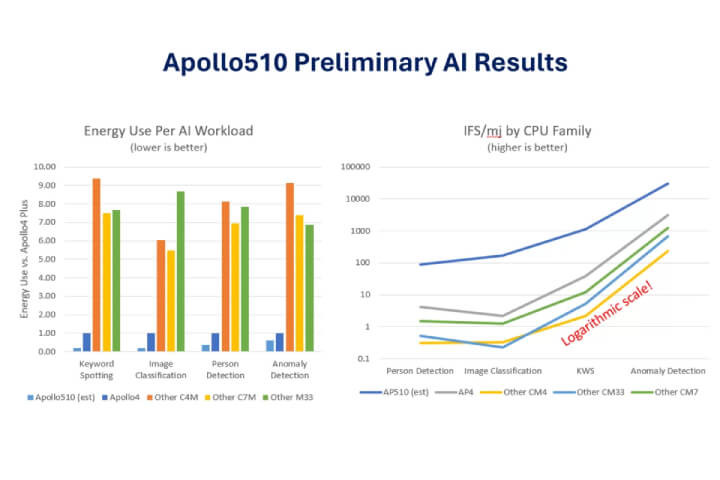Ambiq Apollo510 MCU Boosts Efficiency in AI Wearables
24-04-2024 | By Gary Elinoff

Image source: Ambiq
Key Takeaways about Battery Powered AI devices:
- Battery-powered devices are adopting artificial intelligence (AI) for improved performance.
- AI devices operating at the edge must be power-stingy.
- Devices that exploit this trend will come with varied subsystems and capabilities, but all must include comprehensive security features.
As technology progresses, the imperative to integrate AI into battery-powered devices not only demands innovations in energy efficiency but also reshapes how devices interact with their environment, promoting a smarter and more interconnected world.
Introduction
When we think of artificial intelligence, 6th-generation autonomous aircraft, the industrial internet of things, and, of course, ChatGPT, these are topics that often come to mind. At the other end of the spectrum, there are devices that themselves serve at the “edge” – where the electronic system interfaces with the real, physical world, such as battery-powered AR/VR glasses, factory automation, remote monitoring devices as well as a wearable device that measures the wearer’s heartbeat, blood pressure or other medical parameters. These sorts of devices must be small, and above all else, they must use absolutely the least amount of power possible.
By localizing AI processing within the devices themselves, designers are overcoming traditional constraints related to power, performance, and space, thereby enabling a new era of truly autonomous and mobile devices.
To that end, OEMs are replacing classical computer algorithms with neural network arrangements. The idea is to not only improve performance but to save space and power. But up until now, this would mean the device would have to communicate over the cloud to an AI server. But that would not only introduce latency, but it would also increase weight and size and consume too much power, which is exactly the situation the designers were trying to avoid. The solution relies on ultra-low-power monolithic chips with built-in AI, such as Ambiq’s Apollo5 series, aimed at battery-powered AI applications.
The Apollo510 MCU at a Glance
As described in Ambiq’s Press Release[1], the Apollo510 is the latest in a series of Apollo MCUs, which grew out of the successful Apollo4 Plus family. Recently introduced at the Embedded World Conference, the new unit is the first member of the Apollo5 SoC family. The monolithic unit can process AI and machine learning workloads and, at the same time, tackle telco-quality voice applications, always-on voice/sensor processing, as well as complex graphics.
The Apollo510 features an ARM Cortex-M55 equipped Arm Helium, allowing the device to attain processing speeds up to 250MHz, enabling the unit to deliver 30x better power efficiency and 10x faster performance when compared to previous Apollo devices, while also improving latency by a factor of ten and at the same time using only half the power. Other design bedrocks include 4 MB of on-chip NVM and 3.75 MB on-chip SRAM, and it additionally provides high bandwidth interfaces of up to 500MB/s, enabling the efficient utilization of any off-chip memories that OEM product designers may choose to employ.
Ambiq's Apollo510 brings groundbreaking advancements in microcontroller capabilities, particularly emphasizing its role in powering the next generation of AI-enhanced devices without compromising on efficiency or functionality.

The Apollo510 energy and computing comparisons. Image source. Ambiq
The sine qua non of any battery powered device, with or without AI, is the consumption of the lowest amount of power possible. To that end, Scott Hanson, Ambiq’s CTO and Founder, states, “We at Ambiq have pushed our proprietary SPOT platform to optimize power consumption in support of our customers, who are aggressively increasing the intelligence and sophistication of their battery-powered devices year after year, the new Apollo510 MCU is simultaneously the most energy-efficient and highest-performance product we’ve ever created.”
For more insights, watch this external discussion on the features and impacts of the Apollo510 MCU.
Operating on the Endpoint
As described by Hanson in an ipXchange video[2], cloud based AI may be stupendous, but for him, the bigger story is happening at the endpoint. Devices like smart sensors and smart watches, operating at the endpoint, need to be able to run AI inference for multitudes of purposes that is poised to increase at the speed designers’ imaginations. This is where Apollo5 is targeted.
This strategic focus on endpoint processing is essential for achieving the kind of responsive, intuitive interaction expected from modern smart devices, from home automation systems to sophisticated health monitoring technologies.
Because the Apollo510 can run AI and DSP workloads with 3 to 15 times fewer cycles than previously required, it is, in turn, 3 to 15 times more efficient, requiring far less power per operation.
The Apollo510’s capacity for enhanced performance with minimal power usage makes it ideal for endpoint applications, as noted in the referenced video. These capabilities are critical in modern IoT devices where real-time processing and energy efficiency are paramount.
Don’t Go Off-Chip for Memory
Accessing memory off die imposes huge energy costs, even if that memory is housed on another die which is closely co-packaged directly with the AI engine. However, if designers utilizing the Apollo510 do need even more memory than what is native to the Ambiq device, a rich choice of memory interfaces is available.
The Apollo510’s architectural approach to integrating substantial on-chip memory serves as a crucial factor in its ability to execute high-demand applications efficiently, maintaining Ambiq’s leadership in low-power MCU design.
No Micro MPU – For Now.
MPUs take up a lot of space on the die, and they aren’t needed by many of the Apollo510’s prospective use cases. However, some OEMs will need to run more complex neural networks, and future members of the Apollo5 family will deploy MPUs to meet their needs. Similarly, while the unit’s predecessors featured Bluetooth, this first member of the Apollo5 family does not, again, because many designs simply don’t call for it.
Security
Augmenting Ambiq’s own secureSPOT platform, Apollo510 employs Arm TrustZone technology with a physical unclonable function (PUF), tamper-resistant OTP, and secure peripherals. With these critical features, the Apollo510 enables designers to more quickly and seamlessly establish a trusted execution environment (TEE) for secure, robust applications.
Enhancing these security measures is a direct response to the growing challenges in protecting user data and ensuring device integrity in an era where digital security is paramount.
Software Development to Help Customers
Only once a neural network is built does the metamorphosing process begin, and it can then be directly applied to what Hanson calls bare metal hardware, a charming old term beloved by hardware engineers. The company supplies libraries and utilities to aid the designers in their tasks.
Company supplied AI development kits are also available to serve as useful reference designs. Based on open-source neural networks that Ambiq designs in-house, they hit on many of the hot topics now being pursued on the edge, including speech enhancement. The company hopes that OEM designers will use these kits as starting points and build on them.
Challenges and Opportunities
AI is coming down from the remote server right down to the edge. Designers worldwide are only starting to explore the possibilities that this will entail, and the world is waiting for the first killer app.
The Apollo5 family and its present and future competitors don’t only consume minuscule amounts of power, but they also boast enormous amounts of specialized computational power well beyond what even sophisticated designers may now be used to. Some OEMs may be tempted to stick with their old-school classical computational algorithms.
They may choose to use these devices as merely powerful new muscle to reanimate a now outdated frame and not fully exploit the opportunity to employ AI.
So the challenge here isn’t to leading edge companies like Ambiq, who will either prosper or be bought out, at great profit to the shareholders. The danger here is to companies that will decline if they fail to grab the AI tiger by the tail.
The video also touches upon the dynamic landscape of AI integration in low-power devices, highlighting the challenges of balancing performance with energy efficiency, a critical consideration as the technology continues to evolve and expand into new markets.
Wrapping Up
While ChatGPT may grab all the headlines, there’s a lot happening at the edge and beyond. AI will interpret the hand motions of a device users, analyze their vocal commands and inventory user body readings from tiny, unobtrusive wearables patches and body implants.
But power is a limiting factor, and every microwatt counts. References to external memories, even if housed in the same device, waste power. References to server-based AI are out of the question. That’s why devices like the Apollo510 need to be self contained, and have as much as possible housed on one die, and include the most efficient connectivity to external elements.
References:
- Ambiq Apollo510 Delivers 30x Power Efficiency Improvement to Unleash Endpoint AI: https://ambiq.com/news/ambiq-apollo510-delivers-30x-power-efficiency-improvement-to-unleash-endpoint-ai/
- ipXperience Podcast: https://www.youtube.com/watch?v=Fan7MdyS36o
Glossary of Key Terms:
- OTP. One time password
- DSP. Digital signal processing
- GPU. Graphics processing unit

